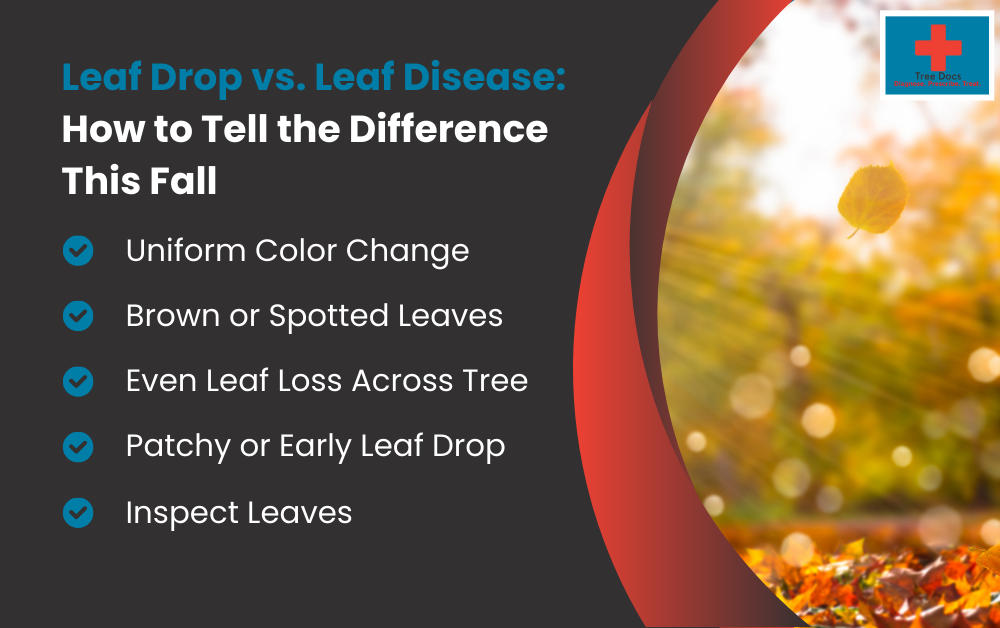As autumn rolls in, trees across Northeastern Ohio begin their colorful display of reds, yellows, and oranges. But what if your tree’s leaves are falling early or looking less like fall foliage and more like a plant in distress? The question many homeowners face this time of year is: Is this normal leaf drop, or is it a leaf disease?
Understanding the difference is crucial. Normal seasonal leaf drop is part of your tree’s natural cycle, but disease-related leaf loss can signal a more serious problem that needs attention before winter sets in.
Why Trees Shed Leaves in the Fall
Most deciduous trees (like maples, oaks, and birches) prepare for winter by shutting down food production. As daylight shortens and temperatures cool, trees begin reabsorbing nutrients from their leaves into their branches and roots for storage. The green pigment (chlorophyll) breaks down, revealing the reds, oranges, and yellows we associate with autumn.
This process—called senescence—is normal and healthy. By the time leaves fall, the tree is already dormant, conserving energy to survive the winter.
Signs of normal fall leaf drop:
- Color changes occur uniformly across the tree
- Leaf drop begins in late September through November
- Leaves fall cleanly without curling, spotting, or shriveling first
- The tree’s canopy looks balanced, not patchy
When Leaf Loss Signals Trouble
Leaf disease or pest issues can also cause leaves to fall—but the pattern is usually different from natural senescence. In many cases, leaves will drop prematurely, sometimes in midsummer or early fall, and they may look unhealthy before they fall.
Common signs of leaf disease:
- Spots or blotches: Brown, black, or yellow areas often caused by fungal pathogens like anthracnose or tar spot.
- Distorted or curled leaves: May point to insect infestations such as aphids or leaf curl fungi.
- Uneven leaf drop: One section of the tree thins out while others remain full.
- Leaves turning brown without vibrant fall colors: Often linked to drought stress, nutrient deficiencies, or root damage.
- Sticky residue or mold: Sap-sucking insects leave behind honeydew, which encourages mold growth.
Common Tree Diseases That Cause Leaf Loss in Fall
Here in Northeastern Ohio, several diseases are known to affect trees in late summer and fall. The most common include:
1. Anthracnose
A fungal disease that causes dark lesions along leaf veins. Often appears in cool, wet weather and may cause premature defoliation.
2. Tar Spot
Recognizable by raised, black, tar-like spots on leaves—especially on maples. It’s more of a cosmetic issue but can lead to early leaf drop if widespread.
3. Leaf Scorch
Not a disease but a stress response, leaf scorch shows up as brown, crispy edges caused by hot, dry conditions.
4. Powdery Mildew
A white, powdery coating on leaves that can weaken them, causing them to fall early.
How to Tell the Difference Quickly
Here’s a quick homeowner’s checklist:
| Question | If Yes, Likely Normal Leaf Drop | If Yes, Possible Disease or Stress |
|---|---|---|
| Are leaves changing to bright fall colors first? | ✅ | ❌ |
| Is leaf drop happening uniformly across the tree? | ✅ | ❌ |
| Are fallen leaves free of large spots, mold, or curling? | ✅ | ❌ |
| Did leaf drop begin later in the season? | ✅ | ❌ |
| Is one side of the tree dropping leaves faster? | ❌ | ✅ |
Why Early Diagnosis Matters
If your tree is dropping leaves because of disease, waiting until spring to act can make the problem worse. Many fungal spores and pests overwinter in fallen leaves or on bark, ready to re-infect when conditions are right again. Addressing the issue now means your tree has a better chance to bounce back next year.
What You Can Do This Fall
- Rake and remove diseased leaves from around the base of the tree to reduce overwintering pathogens.
- Schedule a professional tree health assessment to confirm whether the problem is normal or disease-related.
- Improve soil health with aeration or compost to strengthen the tree’s immune system.
- Prune affected branches when appropriate to prevent spread.
Call Tree Docs Before Winter
If you’re not sure whether your tree’s leaf drop is normal or a sign of disease, our ISA Certified Arborists can help. We’ll inspect your trees, diagnose any issues, and recommend the right course of action—whether that’s simply enjoying the fall colors or taking steps to protect your trees before winter.
Don’t leave it to guesswork.
Call Tree Docs today at (330) 888-8044 or contact us online to schedule your fall tree health check.



